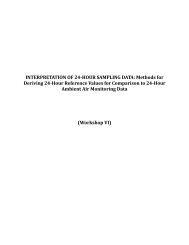Outdoor Wood-Fired Boilers - Alliance for Risk Assessment
Outdoor Wood-Fired Boilers - Alliance for Risk Assessment
Outdoor Wood-Fired Boilers - Alliance for Risk Assessment
Create successful ePaper yourself
Turn your PDF publications into a flip-book with our unique Google optimized e-Paper software.
Due to relatively low stack heights, typically less than 10 feet, OWB emissions may not<br />
always be carried up above neighboring buildings. In rural conditions this is less<br />
problematic, since neighbors are generally further apart, but OWBs are appearing in<br />
urban settings with smaller lots. OWBs located in such areas can provide neighbors with<br />
irregular, but not infrequent, plumes of wood-smoke.<br />
For example, evaluations of OWB output have reported PM levels ranging from 18 to<br />
269 grams per hour (g/hr) (Valentini and Clayton 1998; New York 2005). In terms of<br />
concentrations, a screening level study conducted by NESCAUM (2006), measured<br />
ambient levels of PM2.5 (particulate matter with a size of 2.5 microns in diameter or less)<br />
within 150 feet of an OWB. NESCAUM (2006) reported maximum PM 2.5 of 8,880<br />
µg/m 3 (micrograms per cubic meter), periodic levels of greater than 1000 µg/m 3 and<br />
frequent values greater than 400 µg/m 3 . Michigan Department of Environmental Quality<br />
constructed a model to evaluate the spatial distribution of PM 2.5 emissions. Assuming an<br />
8 foot stack height, and an emission rate of 1 lb/hr, the model estimated maximum1-hour<br />
average ambient levels of approximately 1,000 µg/m 3 PM 2.5 within an 80 foot proximity<br />
of the stack, 500 µg/m 3 PM within 150 ft, and 250 µg/m 3 PM 2.5 within 200 ft (Figure 2;<br />
NESCAUM 2006). Particles of this size are small enough that closed doors and windows<br />
will not prevent them from entering a house (Washington State Department of Ecology,<br />
2004). However, we did not find an estimate or measurement of indoor air PM 2.5 levels<br />
in a brief literature search.<br />
Toxicology Excellence <strong>for</strong> <strong>Risk</strong> <strong>Assessment</strong> (TERA)<br />
<strong>Outdoor</strong> <strong>Wood</strong>-<strong>Fired</strong> <strong>Boilers</strong>: A Synopsis <strong>for</strong> Urban Use<br />
8





